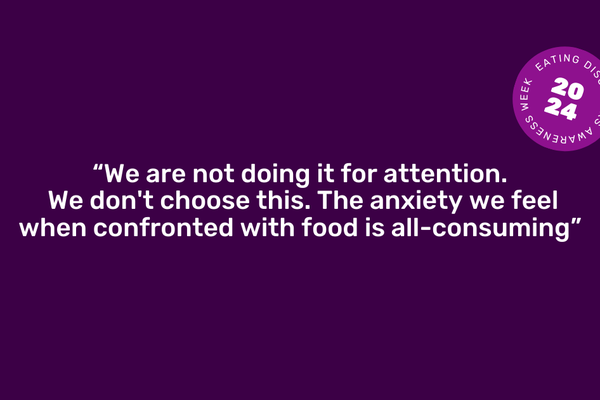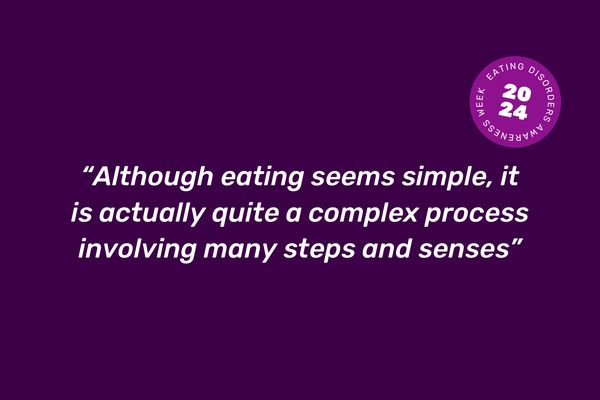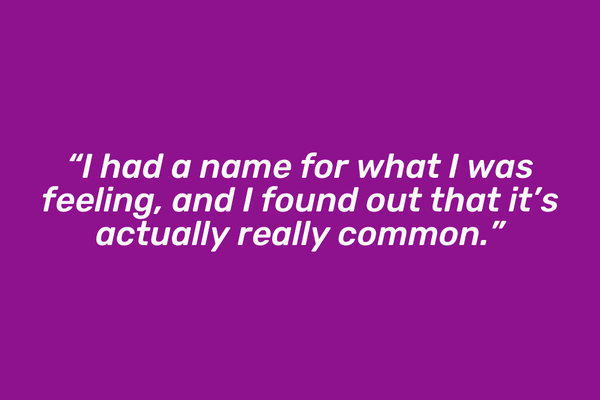All I knew from the age of 18 months was that food was scary and anything out of my ‘norm’ would make me panic. I didn’t have the words to articulate the sheer anxiety I faced day by day. I was instead branded “fussy”, “spoiled” and that I should “just try” foods and I would eventually “grow out of it”. If it were that simple, I’d have tried by now – right? ARFID (formerly known as SED) was not a term I had heard until I was into my teens; by that point, my eating habits were well ingrained.
What is ARFID?
What is ARFID? Avoidant Restrictive Food Intake Disorder was only officially recognised in the DSM-5 (Diagnostic and Statistical Manual of Mental Disorders) when published in 2013; but it had been controlling my life for many years before that.
Unlike other eating disorders, it is characterised by a distinct lack of interest in food and eating, sensory-based avoidance, and / or the concern about the aversive effects of eating. Sufferers typically have fewer than 15 ‘safe-foods’ (that’s individual items – not meals!) and it is common for sufferers to stick to ‘beige’ foods. This can also mean avoiding entire food groups altogether.
For me, it meant that I didn’t eat any meat, vegetables, nor barely any fruit. Even staple foods which a kid typically loves were my nemesis. I feared sauces, nothing on my plate could touch them, and I couldn’t cope with complex foods which had a mixture of ingredients and textures. Even now I struggle not to eat one food item at a time, in a specific order. Furthermore, safe-foods can even be brand-specific. If there wasn’t my usual brand available or it was too expensive, or my mum had tried to sneak an alternative brand, I would know instantly and react to this the same way that I would a new food.
I’d describe my reaction towards trying anything other than my safe foods as a phobic response. My heart would be pounding, my whole body shaking, I felt physically sick – and this was before even eating. Even if I eventually mustered up the courage to put the food into my mouth, before I barely had the chance to chew, I would violently gag and consequently spit the food out. My body physically rejected anything other than what my mind deemed ‘safe’. This is the part people couldn’t seem to grasp, be it peers or even healthcare professionals, the sheer anxiety attached to this. If something made you react like that, would you want to do it again? Would you want to face that every day, thrice?
With ARFID, eating can feel like a chore – it’s a dull, repetitive cycle and every day is exhausting. When I finally received a diagnosis in my teens, although still with no help or guidance, I felt empowered. All the questions and all the noise stopped when I said the words “I have an eating disorder”. There is so much stigma around this term that people fear it, you can see them physically recoil. Although I appreciate my struggles are greatly different from those with other EDs, it wasn’t an incorrect statement. It was a way to feel validated.
Social Effects
Eating disorders don’t just affect mealtimes – they affect everything. Eating is part of everything, it’s everywhere. Countless memories I have of parties or visiting friends’ houses or school trips and the inevitable meltdown that would ensue. I felt so rude and ungrateful.
The day of the year I dreaded the most was Christmas Day. I know this is not uncommon for ED sufferers. For me, it was that it was the one day of the year my family would eat at the same time around the dining table together. The pressure of feeling that everyone was watching me was the most anxiety-wrenching thing. I desperately wanted to be ‘normal’ and be part of the tradition and would try something each year which, without fail, always ended in tears.
The Peak
The summer I sat my GCSE exams was probably the lowest point in my life. I became ever increasingly aware that everything I was putting in my body was of virtually no nutritional value. I felt like I could feel the ‘badness’ going in me every time I ate. I was exhausted. Years of trying and hoping, no one to support or understand me - I had got nowhere.
Desperate, I went to the GP again. I vividly recall crying my eyes out to him only to hear “I can’t give you a magic pill to cure you overnight”. As nice as that would be, I just wanted someone to understand, make my everyday struggles feel validated. I was referred to CAMHS, but I dropped out before treatment began. Sadly, there is still not a standardised treatment for ARFID.
Recovery Journey
It was two years later that I decided to try again. I had heard about a girl like myself in the news and how she had been miraculously ‘cured’ of SED (ARFID). Meeting someone like me was the comfort and support I’d always yearned for; I finally wasn’t alone.
I opted to go for the same therapist she’d gone to as they clearly had some form of awareness of my ED. This was the first glimmer of hope I’d had in years. It has always been a lifelong goal of mine to spread awareness of ARFID, so I wanted to do exactly what she had done for me and give hope to someone else out there, suffering in silence. So, with a lot of encouragement from my ‘therapist’, I agreed to share my story with the media.
In what I thought was doing good for others, only turned out to be toxic for me. The media did what the media does best and exacerbated everything by fabricating a ‘freaky eater’ narrative, which is neither informative, nor helpful. It focuses heavily on the dietary specifics as opposed to the debilitating characteristics of the condition itself. They portray this as an ‘addiction’ and as a result create even more of stigma. How could I be addicted to said food when my ED is characterised by a distinct lack of interest in eating?
After this ongoing battle, I learned that I hadn’t been helped quite as much as I’d thought. I learned that something as complex and multifaceted as an eating disorder cannot simply be “cured” in one session – as ideal as that would be. Instead, myself and others I had met on the way, needed the tools and space to be able to rebuild and adapt to a life without an ED, as the habits of which are ingrained over a lifetime. It shapes your life; it becomes a comfort. It can be so hard to learn what life is like without it because I literally never knew any differently – it felt part of my personality.
Present
I am writing largely in the past tense, but this does not mean my troubles have gone away. My problem now is after years of fighting to prove that I am not just a “fussy eater”, recovery makes me feel that the more I eat, the more I adhere to this label and people will not believe what I went through.
It is not all doom and gloom. I am in a position now where I have lived this recovery and finally feel ready to tell the world – in my OWN words. Although I’m nowhere near my end goal or a ‘normal’ eater, that is something that I have accepted. Recovery is not linear. I’ve lived independently for 4 years, finally been able to go (and live) abroad and I have eaten things I could have never imagined.
I am writing this now for you and for anyone out there lost and unheard. I made a promise to myself to be the voice for those who are not being listened to. I will use my journey to not stop speaking out until there is a standardised therapy, until there is adequate research, until recovery no longer feels like a fairy-tale. I am your voice.
Contributed by Jodie
“You are more than your eating disorder” – What do people affected by ARFID wish we knew?
22 February 2024We asked people affected by ARFID what they would like others to know about the often misunderstood condition.
“Eating is actually quite a complex process” - dietitians Sarah Fuller and Clare Ellison on ARFID vs 'picky eating'
19 February 2024Advanced eating disorder dietitians Sarah Fuller and Clare Ellison discuss the difference between ARFID and 'picky eating'.
Finding ARFID - Frankie's story
1 February 2024Our supporter Frankie shares their experience of discovering they have ARFID, and how far they've come in their recovery


